He was the all-American boy. Handsome. Smart. Charming. In fact, Theodore Robert Bundy was the stereotype of what every American boy ought to be like and what every American parent wanted their sons to aspire to. Above all, Ted Bundy was charming; he had a winsome way that could entrance people.
Yet, this same college wunderkind snuffed out the lives of scores of beautiful young women. He was a charismatic killer whose Jekyll and Hyde personas were so vastly different that he fooled his closest associates for years, many of them still not believing that their “Ted” could commit the atrocious crimes that were piling up alongside his name even as the evidence became overwhelming.

He made a mockery of law enforcement, running rings around their attempts to catch the world’s first ‘serial’ killer. Bundy’s brilliant mind made him a master predator, with his abductions being as well planned as a military action.
He has gone down as the most infamous serial killer in US history. Today, decades after his execution in the electric chair, he is held up by many as a macabre celebrity, the poster boy for mass murder. His story is a paradox. In his past there were no signs of the deviant behavior that would manifest itself in an insatiable blood lust. He was, in fact, on track for a brilliant career on the other side of the law – as a prosecuting attorney. His performance in his own defense showed what great promise that career held.

Upon sentencing Bundy to die, Judge Edward O. Cowart summed up the feeling of so many that knew and were affected by Bundy.
It is a total waste of humanity that I have experienced in this court. You are a bright young man. You’d have made a good lawyer. I’d have loved to have had you practice in front of me. But you went another way, pardner.
In examining Bundy’s story, we may get closer to answering the question as to why he chose the way he did. But, then again, we may never know.
Formative Years
Theodore Robert Bundy was born to 22-year old Eleanor Louise Cowell on November 24th, 1946. His father was a sailor who never hung around to meet his newborn son.
When he was four, Ted’s mother, who he was told was his older sister, took him 3,000 miles away to Tacoma, Washington to live with family members. Ted was heart-broken to be taken away from his grandfather, with whom he had developed a special bond.
Although no-one ever replaced his grandfather in his affection, Ted some became close friends with his two cousins, Jane and Alan Scott. Meanwhile his mother was making a friendship of her own. Eleanor was now going by the name of Louise. She joined the Methodist Church and soon crossed paths with a young man by the name of Johnny Culpepper Bundy.
Johnny Bundy stood only five foot tall. He was a cook and came across as a shy, reserved kind of guy. But Louise sensed that he was kind and dependable. Soon a romance had blossomed. After a whirlwind of Methodist social functions, Louise and Johnny were marred on May 19, 1951.
The family bought a home near Narrows Bridge. While Johnny kept on working as a cook, Louise turned her hand to secretarial work. Children followed; two boys and two girls. As he grew up, Ted was often pressed into babysitting service. He willingly complied, even though it would usually mean missing out on outings with his friends.
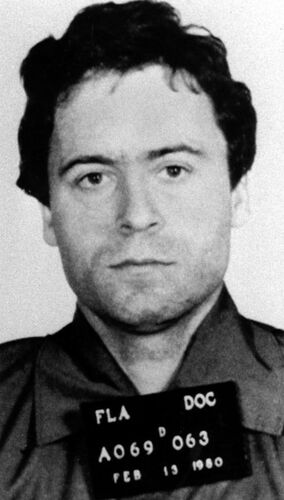
Although the family dynamics were stable, Ted was to grow up in an environment of untruths and uncertainty. He was still being fed the line that his mother was his sister and that his grandparents were actually his parents. During his years at high school, he ran with kids who had connections, whose parents were rich or who were big noters in the school environment. Ted could never match up. As a result, he was often teased. Where others were outgoing, Ted came across as shy and reserved.
Ted never warmed to his father-in-law, despite Johnny’s acceptance of him and attempts to build a relationship. When Johnny became a scout leader and organized camping trips, Ted would usually find some excuse as to why he couldn’t attend.
“I don’t feel guilty for anything. I feel sorry for people who feel guilt.” Ted Bundy
In adolescence Ted grew rapidly, but he found it very hard to put on muscular size. He was too skinny to play football, though he did join the track team at Hunt Junior High. However, it was the classroom, rather than the track field, where Ted felt most comfortable. He maintained a B average, taking his schoolwork and homework very seriously.
Ted graduated from Woodrow Wilson High School in 1965. While he was making solid progress academically, he was also beginning to build a reputation that was not so favorable. He had already been in trouble with the law in relation to some petty burglaries. He was also proving himself to be an unreliable worker.

After graduating high school, Ted began working for Tacoma City Light. His plan was to attend college and he enrolled in the University of Puget Sound for the 1965-66 year. Twelve months later he transferred to the University of Washington in Seattle. He began living on campus in a dormitory room at McMahon Hall.
At the University of Washington, Ted’s winning personality began to manifest itself. He was charming, well dressed and came across as educated. His professors thought that he was a brilliant, studious individual with enormous potential. Ted’s charm and good looks made people see beyond the emptiness that was at his core.
Stephanie
It was during his freshman year at Washington U that Ted first fell in love. The object of his desires was a beautiful, dark haired girl that lived nearby. She was, as he would later describe her, the most beautiful creature he had ever seen. He found out her name, Stephanie Brooks. From a distance, Ted admired her, studying her like a specimen under a microscope. He stared at her in the lunchroom, fantasizing from afar. It soon became apparent that Stephanie was into the football jock crowd and Ted became despondent.
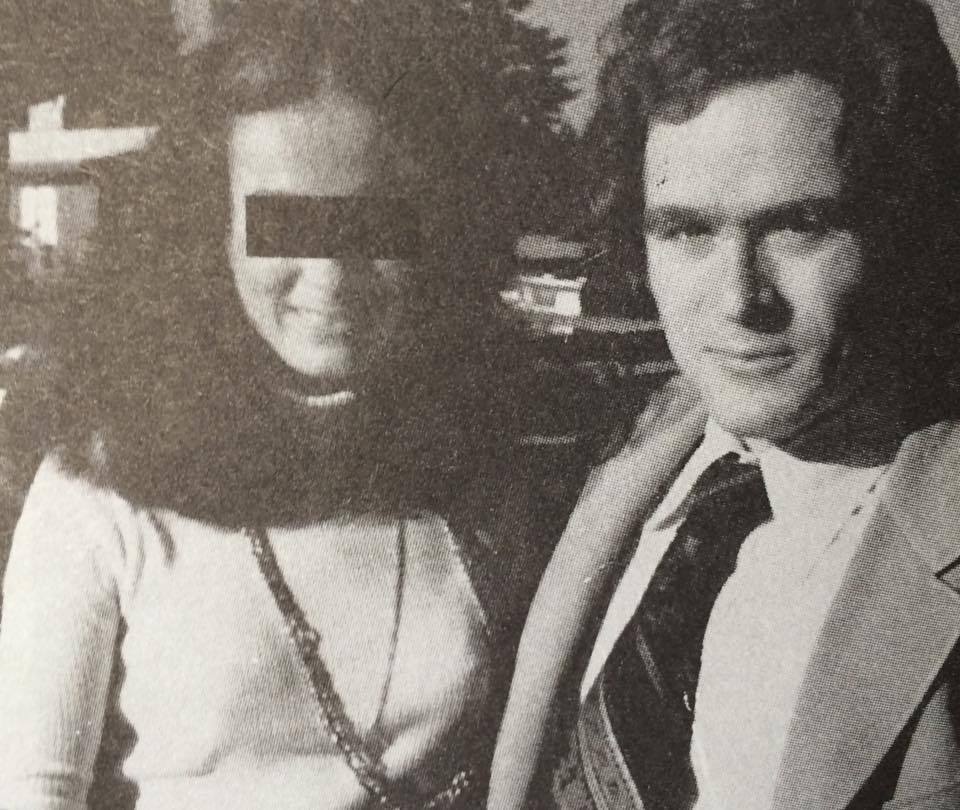
Despite their differences, there was one thing that Ted and Stephanie had in common. They were both skiers. Perhaps this could be his in. Showing signs of overcoming his insecurities, he took the bold step of asking if he could hitch with her to the ski slopes east of Seattle. She readily agreed, happy to have some company.
This was the start of an unlikely romance. The pair started spending more time together. Stephanie seemed to enjoy his company and sought him out. As for Ted, he had become besotted with Stephanie. He was besotted with her. Soon they were lovers.
Stephanie was 21, Ted 20. She was from wealthy California stock; he was illegitimate. She grew up in the midst of money; he didn’t have anything. Yet, their relationship worked and they went steady for the next year.
For Stephanie, the year with Ted was an enjoyable extended fling. She was in love with him, sure, but not in the way that he was with her. She had known from the start that the relationship was never really going anywhere. They’d spend some time together, enjoy themselves and then go their separate ways. After all, there was no way that Ted could ever fit into her society.
Stephanie’s graduation in June 1968 seemed like the opportune time to end the romance. She’d be moving to San Francisco to find work while Ted stayed on in Seattle to finish his studies.
To say that Ted took the rejection from Stephanie badly could well be the ultimate understatement. He was absolutely devastated. Crime author Anne Rule, who worked with Ted on a Seattle Crisis hotline, believes that the breakup of his relationship with Stephanie was the catalyst for everything that followed in Ted’s life.
Ted could not accept that the relationship was over. He immediately set about finding ways to woo Stephanie back. He also immersed himself in law and politics, as if to drown out the agony of losing her.
Ted’s despondency spread to his academic life. The once brilliant student was now struggling. By the fall of 1968, he had dropped out completely. After several months of wallowing in despair, he re-enrolled at the University of Washington, taking papers in psychology that included deviant personality and deviant development. Throwing himself into his studies, he impressed his professors as an honor student who was truly gifted.
“What’s one less person on the face of the earth, anyway?” Ted Bundy
Despite his rigorous study schedule, Ted still found time to frequent the bars of the university district. In September, 1969 the handsome, affable young man caught the eye of a woman named Meg Anders. They were both alone at the Sandpiper Tavern. Ted made the first move, asking if he could buy her a beer. Reluctant at first, she was soon won over by the ‘Ted’ charm. Before she knew it, she had given him her phone number.
Ted and Meg began spending evenings together. Meg quickly came under Ted’s spell, falling deeply in love with him. In a sense, this was a reversal of Ted’s relationship with Stephanie. Meg adored the ground that Ted walked on. Yet, he was less committed, his mind often on other things and other people. He was still pining for Stephanie but Meg would do in the meantime.
1969 and ’70 were stable years in the life of Ted Bundy. He was focused on his academic progress, impressing his professors and gaining qualifications that would lead into his chosen legal career. His relationship with Meg was steady, with Ted playing the part of the surrogate father to Meg’s young daughter Liane with passion and joy. During 1970, Ted was awarded a commendation by the Seattle Police Department when he ran down a purse-snatcher. A few months later he saved a drowning toddler at Green Lake.
Ted had transformed himself into the all-American boy.
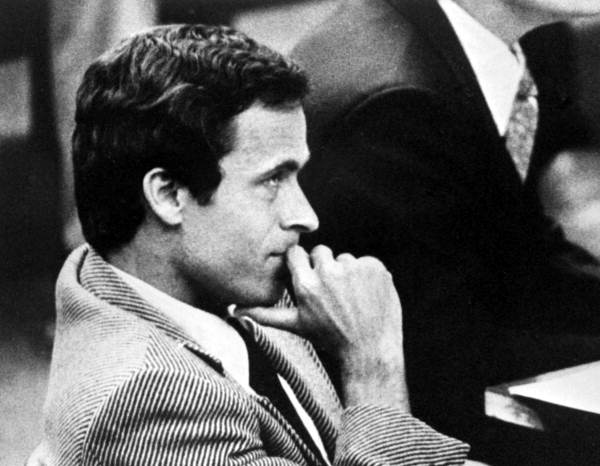
In the beginning of 1971, Ted took a part time job at The Seattle Crisis Clinic, situated on Seattle’s Capitol Hill. He did the 9pm to 9am shift a few nights a week. On a Tuesday night, between 10pm and 2am, he was partnered with a 39-year-old part time crime writer named Ann Rule. For ten months they worked together, the crime writer and the future serial killer. They worked tirelessly to help solve people’s problems. On many occasions they helped save people’s lives.
Ted was an amazing counsellor. Always calm, he had an aura to his voice that put people at ease. He reassured, guided, entertained and empathetically listened.
In April 1973, Ted was awarded the position of assistant to Ross Davis, chairman of the Washington State Republican Party. Along with the job came a $100 per month salary, use of a credit card and expenses paid travel.
By this time, Ted had been with Meg for four years. Their relationship was steady, although it often felt like Meg was doing more of the giving than Ted was. Still, he was excellent with little Liane, who adored him. Marriage seemed just over the horizon.
What Meg didn’t know was that Ted still carried an unquenchable desire for Stephanie Brooks. Even when he and Meg were making love, it was Stephanie’s image in Ted’s mind. And so it was that, when he flew to San Francisco on a Republican Party business trip in the summer of 1973, he looked her up.
Ted and Stephanie went out for dinner. She was bowled over by the changes he had made. Now he was sophisticated, confident and in control. And, it appeared he had money. Ted’s plan to win her over worked perfectly and, on parting, she agreed to come and see him in Seattle. She did just that during her autumn vacation.
Ted took Stephanie to dinner at the home of his boss, Ross Davis. He introduced her as his fiancée. Then he whisked her off for a weekend at the snow at Cascade Pass. He had booked a luxurious condo just for the two of them. Over the course of that weekend Stephanie fell in love with Ted all over again. When he began talking of marriage plans, she excitedly joined in. Future plans were made for a life of domestic bliss.
Of course, neither Stephanie nor Meg knew of the other’s plans to marry Ted Bundy. After his weekend with Stephanie, however, he began to evade talk of marriage with Meg. He seemed to be getting very cold feet.
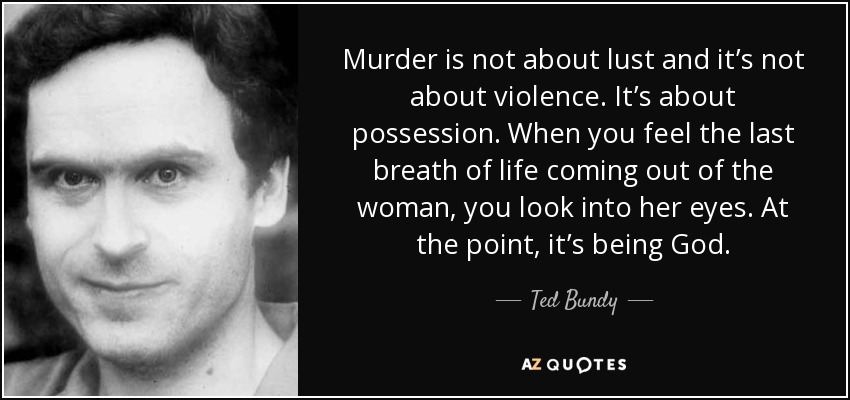
Towards the end of 1973, Ted managed to coordinate his two love lives so that he could wine and dine Stephanie more liberally. He brought her to Seattle and they dined at various restaurants throughout Chinatown.
Strangely though, Stephanie was sensing that something was different. Ted was becoming less affectionate. He stopped taking about marriage plans. He confessed that he had been having an affair with another woman and that she had ended up having an abortion. He was becoming cold, clinical and uncaring towards Stephanie. He didn’t even buy her a Christmas present.
Despite her attempts to get to the bottom of his strange change in attitude, Stephanie was unable to discover why Ted had become so cold toward her. But he just wouldn’t let her in. When she flew back to San Francisco at the start of the new year, Ted appeared glad to be getting rid of her.
Stephanie waited for Ted to reach out for an explanation as to why he had turned. It never came. In February, 1974, she phoned him, angrily demanding an explanation. He hung up on her.
Stephanie would never again speak to Ted.
The Nightmare Begins
During the first six months of 1974, eight women went missing from college campuses in Washington, Oregon and Utah. When you look at photos of these women you can’t help being struck by how alike they looked. They all had small frames, long hair that was parted in the middle and were good looking. Every one of them resembled Stephanie Brooks.
As the case files mounted, still the killer left no trace. Investigators were surprised and immensely frustrated that a man could commit such brazen abductions and leave absolutely no trace evidence in his wake. Indeed, each attack would be slightly more brazen than the last. The abductor would snatch girls who were in closer proximity to others – almost as if he was daring anyone to stop him.
Lake Sammamish
Located at the Southern end of Lake Sammamish in King County, Washington, Lake Sammamish State Park covers 512 acres and features 6858 feet of waterfront. The level landscape features buttercup filled pastures and is dotted with trees. In the summer of 1974 it was a popular bathing spot and sunning for thousands of local residents. Lifeguards patrolled and there was a rangers hut on site.
On Sunday, July 14, 1974 Lake Sammamish was packed with in excess of 40,000 people who were eager to make the most of the glorious summer’s weather. Among the throngs of sun seekers on that day was an attractive young woman who was sunbathing by herself on the beach. No sooner had she settled into her tanning session than she looked up to see a man towering over her.
He was wearing white t-shirt and jeans, and his right arm was in a cast.
“Excuse me, I’m sorry to bother you,” he began, “I was wondering if you could help me out.”
The girl looked him over. He was good looking and seemed somewhat nerdy to her. She didn’t sense any danger.
“Help you out with what?” she asked.
He then knelt down beside her and explained that he needed to launch his sailboat but couldn’t do it with his cast on. He offered to take her for a ride in the boat and was exceedingly charming.
Yes, she would go with him, she said. As they were walking to where the man said his sailboat was he offered his name, ‘Ted’.
It was about this time that the girl got cold feet. She begged off saying that her parents were waiting for her.
Two other young women at the lake that day weren’t so lucky. Twenty-three-year old Janice Ott and eighteen-year old Denise Naslund went along with ‘Ted’ – and were never seen again.
Ted had dramatically upped the stakes. Not only had he freely given his name to his potential victim, but he had approached at least six women on that Sunday afternoon in broad daylight. Clearly, Ted was feeling invincible. There was nothing that the bungling law enforcement officials could do to stop him. He was way too clever for them.
Police were able to produce a composite sketch of Ted based on the statements of the eyewitnesses. This was circulated up and down the country. Three thousand five hundred tips poured in from the public. The police compiled a list of potential suspects named Ted. Bundy’s name was among the more than 2,000 on that list.
Utah Killings
Ted moved to Salt Lake City on Thanksgiving weekend 1974 to attend law school. He immediately secured a job as a security guard at the university. The initial focus of the Utah killings was one of the small towns that lay within the vicinity of Salt Lake City.
They began on October 2, 1974. The victim was 16-year-old Nancy Wilcox. She disappeared from Holladay, a small town just out of Salt Lake City. Nancy had walked to the store to buy some gum. She was last seen by an eyewitness getting into a light brown Volkswagen Bug.
Ted next struck on October 18th. This time the victim was the daughter of the Midvale Police Chief, Louis Smith.
The third Utah victim was 17-year-old Laura Aime, from Lehi, twenty-five miles south of Salt Lake City. It was October 31st, Halloween night. Laura was a high school drop-out, who had moved out of home and in with friends. Bored at the lack of action that night, she had left a local café just after midnight and proceeded to walk to a local park. She was never seen again.
Less than a month later Ted abducted an 18-year old girl from a local mall by impersonating a police officer. Fortunately, she managed to break free from his car moments after he had slapped handcuffs on one of her wrists. A frustrated Ted drove for another 17 miles before coming to Viewmont High School, where a school production was in progress. He abducted and killed 17-year old Debbie Kent.
In 1975, Ted found a new killing zone – Colorado. It appears he murdered at least five women during a six-month period, burying their skulls in a bizarre graveyard in the Taylor Mountains.
Caught, But Not For Long
In the early morning hours of August 16th, 1975, the police finally caught up with Ted Bundy. A minor traffic violation led to a search of his car which produced a burglar’s kit complete with handcuffs and rope. Authorities were soon able to connect the dots and charges of aggravated kidnapping and criminal assault charges were laid. He was found guilt and sentenced to one to fifteen years.
For the police this was just the start. They now set about building a case to hold Bundy accountable for the trail of body’s that he had left in his wake. Ted was adamant that he would defend himself in the upcoming trial and was given access to the Aspen Law Library to do research.
During a visit at the Law Library on June 7th, 1976, Bundy managed to slip out of a second storey window. He went straight for the local river bank. He took off his court room outfit, to reveal a second set of clothes underneath. He then brushed himself off and calmly wandered back into the center of the town. As police rushed to set up roadblocks, he wiled away his time browsing in stores. It was classic Bundy. After a week on the run he was recaptured only to break out again six months later.
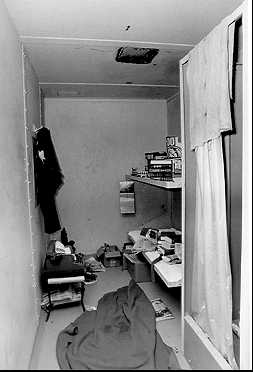
This time he was able to evade recapture and set out for Florida. He set himself up in the vicinity of Florida State University. For over a year he managed to control his urges, until, on the night January 14th, 1978, his demons were unleashed in an orgy of violence that left two girls dead and two more horribly beaten at the Chi Omega Sorority House.
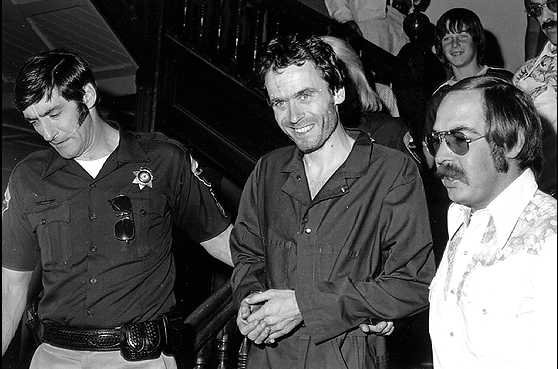
Justice at Last
Over the following weeks, Ted continued his rampage, killing a 14 year-old girl and attempting to abduct another. This girl, the daughter of a police detective, helped police produce an identikit picture and that, along with a series of mistakes on Ted’s part led to his recapture on February 15th, 1978.

This time there would be no escape. After a lengthy trial in which he defended himself, Ted was found guilty of murder and sentenced to death in the electric chair. He spent a decade appealing the decision but was finally executed on January 24th, 1989. By that time the Bundy phenomenon had grown, with a legion of, mainly female, fans, who had fallen in love with Ted and who wrote passionate love letters to him. They conveniently forgot that he was one of the most cold-hearted killers in history.



